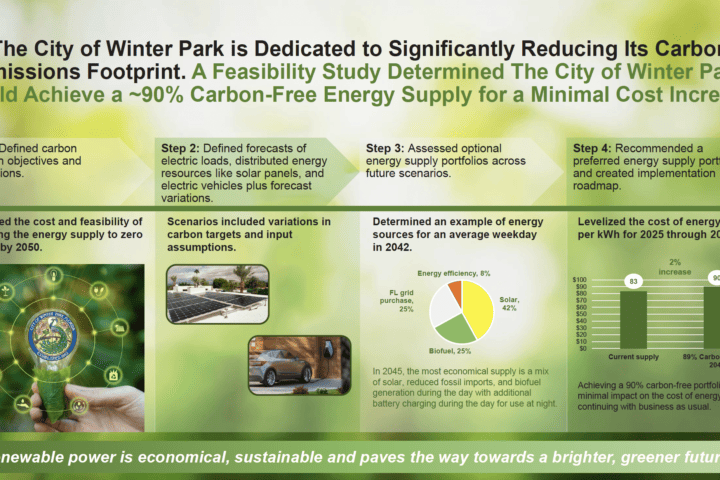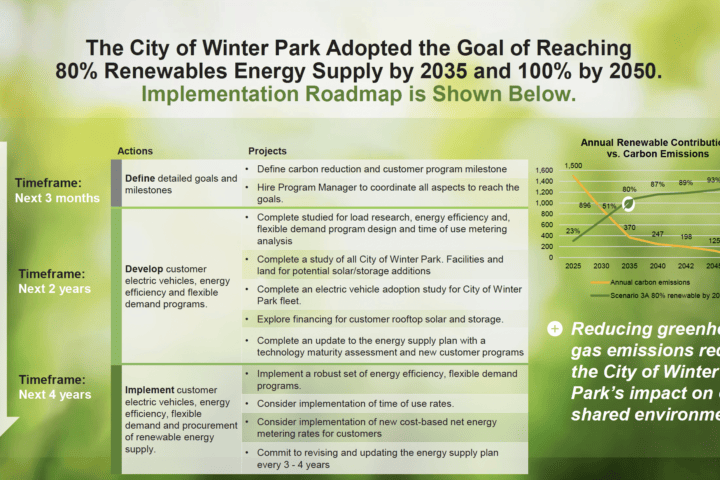In 2024, after years of work with city staff and our consultant, the Winter Park City Commission adopted a high-level GOAL to achieve 80% of our power from renewable energy (mostly solar) by 2035, and probably 100% by 2050. We can get there with our current rate structure, based on the consultant’s financial forecasts. We can get to 80% renewable by 2035 by investing in solar power. In 2035, we can review technology and re-affirm the path to achieve 100% renewable energy by 2050. Setting these goals kicked off the next step of creating an Action Plan to get there. That plan will be ready in the next 18 months.
Years ago, Winter Park chose to purchase the Duke Energy® of Florida system that serves 80% of residents. By controlling our destiny and using the profit to underground our lines, the reliability of our service has skyrocketed. Today, we can choose to invest in renewable energy, just as we chose to invest in reliability years ago. Most residents want to do something to make the city and the region less reliant on fossil fuels. They do not want a “do-nothing” plan. Residents also have real concerns that pursuing a target without some financial controls is not right either.
Therefore, we have adopted a “middle” plan.
- Make a difference in our region.
- Invest in renewable energy.
- Fund at a financial level that is manageable, and always less than Duke Energy.
The city is focused on “real” increases in solar and “real” decreases in fossil fuel in our region. We have financial guardrails never to exceed 95% of Duke Energy prices. Duke is a good benchmark since we acquired our utility company from them years ago. This is clear in the adopting resolution.
Policy Overview
- Renewable energy goals are achievable.
- We can get there with our current rate structure.
- We can shift to investment in renewable energy in 2030, after the Undergrounding Project investment is finished.
- Eighty percent renewable energy by 2035 is achievable by mainly investing in solar power, a known technology that is dropping in cost.
- Setting the Goals is only Phase 1.
- Creating an Action Plan is Phase 2, which will be completed in the next 12-18 months.
- Choosing Solar Investments before 2031 is Phase 3.
- Phase 4 is re-affirming the path to achieve 100% renewable energy by 2050, after reviewing technology and costs in 2035 and again in 2042.
- The adopting Ordinance has the following conditions:
- Must have a regional impact that actually creates more renewable energy and actually reduces fossil fuel reliance. (This NOT buying carbon credits.)
- Must cost less than 95% of Duke Energy® of Florida since we bought our system from Duke Energy.
- We control our own destiny and can always adjust and enhance the plan.
The Steps to Renewable Energy
Phase 1 was setting the goals for 80% and then 100% renewable energy.
With guidance from Quanta Technologies (the consultant), city staff, the Utilities Advisory Board and Keep Winter Park Beautiful & Sustainable Advisory Board, the City Commission adopted the goals in January 2024. The goals are based on forecasts and analyses conducted over two years and presented in Quanta’s Integrated Resource Plan (IRP) Report. This report was a feasibility analysis of the cost and options to transition the power supply to 100% renewable sources.
Phase 2 is Creating an Action Plan.
Creation of the Action Plan is outlined in the Quanta Final Report and will be completed in the next 12-18 months.
Phase 3 begins implementing the Action Plan by choosing solar investments before 2031.
The undergrounding project is to complete on or before 2030. Upon completion, the city can invest in renewable energy sources.
Phase 4 is re-affirming the path to achieve 100% renewable energy by 2050.
After achieving 80% renewable energy, in 2035 the city will review technology and costs and reconfirm the appropriate technology to continue our progress to 100% renewable energy. It is expected this review will occur again in 2042.
Keeping the Current Rate Structure
If we keep our current rate structure, we can build up our financial reserves after the undergrounding project is complete. Those reserves allow us to make choices beginning in 2031.
Those choices include:
- Investing in solar fields with partners so that future solar power is cheaper: “at cost” wholesale prices instead of retail prices. By investing directly in renewable energy, we are assured of lower costs than retail prices.
- Investing alongside federal and state grants in energy conservation incentives for residents and businesses to install heat pumps, insulation, and windows. These efforts reduce how much power we have to build or buy, cutting fossil fuel use faster.
Quanta, our consultants, helped prepare a financial forecast, the “Base Case” plan for Renewable Energy. This Base Case is just one way to meet our goals. For now, all we are doing is putting a plan together with the end goals in mind. That plan will be adjusted over time to respond to technology, investment options, the economy, and financial constraints. The first really big choices come in 2031 as undergrounding is complete.
Key Financial Forecast Points
- The financial forecast behind our goals keeps the existing rate structure without exceeding inflation. We can achieve our goals by continuing to invest our profits in better energy after we finish the undergrounding.
- The plan focuses on solar IN OUR REGION, which will displace and reduce fossil fuel use IN OUR REGION. We are NOT buying energy credits or building solar farms in South America. The adopting resolution is clear on that.
- Our proforma “base plan” is close to the same cost as if we continued to purchase from current providers, like Duke and FMPA. The “fossil fuel plan,” still has cost increases. Their costs increase from the added costs of phasing out fossil fuel and building capacity. This analysis is a big part of the study.
Key Assumptions for Renewable Energy Study – Excerpts
1. In adopting these targets, the commission has assumed that the cost of renewable technologies will drop over time. Historically, emerging technologies have achieved similar reductions in cost as economies of scale and engineering advances work together. For example: the microprocessor computing power for an iPad 2 dropped from $100 million in 1980 to $1,000,000 in 1990 to $100 in 2010, huge reductions over 30 years; and the cost of solar power dropped from $700 per kWh in 2010 to under $200 per kWh in 2018, an 8-year period. See Forbes article “Declining Cost Curves Create Opportunities for Investors” 10-17-2018. There is no assurance however that the costs will decline as assumed.
6. Quanta Technology used PPA pricing from existing CWP contracts and other data available for Florida power costs to estimate that future purchases from the Florida grid would. Florida currently relies principally on fossil-fueled resources. However, as FPL and other utilities evolve their system to cleaner resources, the power costs from the Florida grid are estimated to escalate at 2% annually regardless of the CWP decisions for its power supply. Quanta Technology also assumed that the purchased power market in Florida would continue to provide CWP options to purchase specific types of power from large suppliers, such as FPL, OUC, and FMPA.
14. In the forecast for the production costs for years 2043-2050 when Clean Hydrogen Combustion Turbine (CT-Hydrogen) begins to play an important role in the renewable energy strategy, the Commission has assumed a cost for power from a portfolio of substantially carbon free resources will average of $133/MWh for power costs in 2042. This cost reflects the costs prior to the introduction of any costs associated with a CT-Hydrogen resource or another clean technology that could supply a firm dispatchable resource. In this analysis, the addition of the CT-Hydrogen resource is forecasted to drive the average power costs to $255/MWh in 2050, largely due the cost forecast of clean hydrogen costs of $366/MWh in 2050.
The Commission is unwilling at this time to accept a plan through 2050 that includes the current costs assumptions for CT-Hydrogen. At this time, the Commission can support a conditional plan that establishes an upper limit to the average power costs after 2042 that would not exceed 3% escalation from the costs forecast for 2042. This 3% escalation limit would require a significant reduction in the costs of CT-Hydrogen or an alternate carbon free generation technology that could serve the same role in the city’s power portfolio.
The Commission is willing to accept power costs reflecting a 3% escalation from the 2042 costs of $133/MWh, yielding a maximum acceptable average power costs in 2050 of $168/MWh.
Additional Information
- Resolution 2281-24
- Sustainability Action Plan contains a complete list of Key Assumptions including the excerpts from the final Quanta Report below.
- Quanta Technology Customer PowerPoint Presentation



